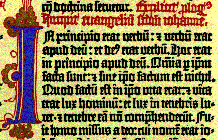Some Thoughts on Web Design
Jay David Bolter
Do current designers know how to design documents for the World Wide Web? In one sense, they can't know because the web, hypertext, and electronic writing are in their infancy. Word processing is only a few decades old. Hypertext, first conceived by Vannevar Bush in the 1940s and elaborated by Ted Nelson in the 1960s, only became practical in the 1980s. We are still in the age of electronic incunabula.

Gutenberg's 42-line Bible was published in the 1450s. It looked almost exactly like a handwritten codex of presentation quality. His Bible still made use of approximately 300 letters, ligatures, and abbreviations developed by contemporary scribes. Its pages were dark with ink, imitating the thick strokes of the scribe's pen. Gutenberg even left room for illuminated capital letters to be painted on the page. In the beginning of the age of print, the written word remained the paradigm. Elizabeth Eisenstein explained in The Printing Revolution in Early Modern Europe : "The absence of any apparent change in product was combined with a complete change in methods of production, giving rise to the paradoxical combination of seeming continuity with radical change."
It took printers several decades to disrupt the seeming continuity and develop modern typography and book design. However, the books of early period were not inadequate or primitive: they functioned perfectly well as replacements for manuscripts.
The same is true of many current web designs.
